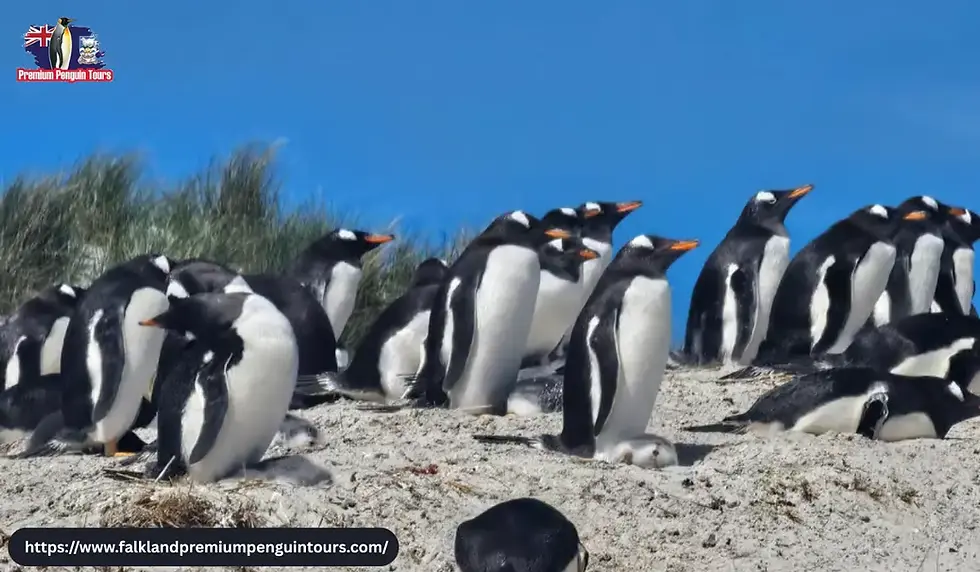Things to Do in Yorke Bay Penguin Colony
- Jimmy Anderson
- Aug 6
- 4 min read
Discover the Charm of Yorke Bay
Nestled just east of Stanley, Yorke Bay Penguin Colony offers a serene and immersive wildlife experience in the Falkland Islands. With a sweeping white-sand beach and a thriving penguin population, it’s the perfect place for nature lovers, photographers, and families.
Whether you’re watching Gentoo penguins waddle to the sea, strolling the pristine coastline, or soaking up panoramic ocean views, Yorke Bay promises a memorable adventure.

Top 5 Things to Do in Yorke Bay Penguin Colony
Yorke Bay isn’t just a beach—it’s a front-row seat to the Falkland Islands' most charming wildlife. Whether you're here for penguins, photography, or peaceful walks, there’s something unforgettable awaiting you.
Quick Overview
Activity | What You’ll Experience |
🔭 Penguin Watching | Observe playful behaviors, nesting, and waddling up close |
📸 Wildlife Photography | Capture iconic shots of Gentoo penguins and scenic landscapes |
🚶♂️ Beach Walks | Enjoy peaceful strolls with views of penguins in their natural habitat |
🌅 Scenic Views | Admire sweeping coastal vistas and remote tranquility |
📚 Learn Local History | Discover Yorke Bay’s unique role during the Falklands conflict |
1. Watch Penguins in Their Natural Habitat
Yorke Bay is one of the best spots in the Falkland Islands to observe Gentoo penguins in the wild. These charming birds are highly social and often nest in large colonies near the sand dunes. During the breeding season (October to March), you can see them engaging in fascinating behaviors:
Mating dances and calling rituals
Nest building using pebbles and grass
Feeding and caring for fluffy chicks
Waddling to the sea in tight-knit groups
You don’t need binoculars or long hikes—penguins are easily visible from the main walking path. Unlike other sites that require 4x4 access, Yorke Bay is accessible even on foot from Stanley, making it ideal for short visits and families.
Did You Know? Gentoo penguins can reach speeds of up to 36 km/h while swimming—making them the fastest underwater birds on the planet!
2. Capture Stunning Wildlife Photography
Whether you’re an amateur or professional photographer, Yorke Bay is a dream location for penguin photography:
Golden-hour light in early morning and late afternoon gives perfect natural tones
Wide open beaches offer unobstructed shots of penguins against the sky or sea
Penguins are accustomed to humans, so you can get relatively close (while keeping a respectful distance)
Pro Tips:
Bring a zoom lens (200–400mm) for crisp close-ups of individual penguins or chicks
Use a wide-angle lens to capture dramatic group shots with seascapes or sand dunes
Don’t forget candid photos of penguins sliding on their bellies or play-fighting!
3. Take a Scenic Beach Walk
Yorke Bay’s white sand and turquoise water make it one of the most beautiful beaches in the Falkland Islands. The bay was once a mined zone after the 1982 Falklands Conflict, but thanks to a decade-long demining initiative, it is now completely safe and open to the public.
Walking here, you’ll experience:
Tranquil ocean sounds and seabirds overhead
Penguin footprints scattered across the sand
Sweeping views of the South Atlantic horizon
It’s a great place to relax, reflect, and connect with nature. Don’t rush—take your time walking the full length of the beach.
Fun Fact: The penguins’ light weight meant they never triggered landmines, which ironically helped protect the beach’s ecosystem from human intrusion.
4. Spot Other Wildlife
While penguins are the main stars, Yorke Bay is teeming with life:
Sea lions can sometimes be spotted lounging on distant rocks or swimming in the surf
Magellanic penguins burrow in grassy areas and are often seen alongside the Gentoos
Cormorants, skuas, and upland geese patrol the skies or wander near the dunes
Lucky visitors have reported dolphin sightings just offshore
Bring your binoculars, or just sit quietly and observe—the more still you are, the more you’ll see.
5. Visit Volunteer Point (Optional Day Trip)
If Yorke Bay sparks your curiosity for penguins, consider extending your adventure with a trip to Volunteer Point, just a 2.5-hour off-road drive from Stanley. It’s home to the largest King Penguin colony in the Falkland Islands.
Highlights at Volunteer Point include:
Seeing three penguin species in one location (King, Gentoo, and Magellanic)
Watching thousands of King Penguins in their regal plumage
Experiencing remote, untouched landscapes on the drive through East Falkland
Many local tour companies (including ours) offer combo packages so you can experience both Yorke Bay and Volunteer Point in a single day.
Quick Travel Tips
Wear windproof jackets — the coast can be breezy.
Bring binoculars to spot birds and distant wildlife.
Stay on marked paths to protect nests and vegetation.
Respect the space of penguins: observe quietly and avoid sudden movement.
Frequently Asked Questions (FAQs)
Is Yorke Bay safe to visit after the landmine clearance?
Yes. As of 2020, all landmines have been removed from Yorke Bay. It’s now completely safe and open to the public, as confirmed by the Falkland Islands Government and international demining experts.
What wildlife can I see besides penguins?
You may spot Magellanic penguins, sea lions, dolphins, and a variety of seabirds including skuas, cormorants, and oystercatchers.
How long should I plan to spend at Yorke Bay?
Most visitors spend 1.5 to 3 hours, depending on how much walking and photography they want to do. The area is serene, so it’s also great for just sitting and observing.
Is there any Yorke Bay entrance fee?
No. Yorke Bay is completely free to access, making it a budget-friendly wildlife experience.
Are there restrooms or facilities in Yorke Bay?
There are no restrooms or cafés at Yorke Bay itself. Be sure to use facilities in Stanley before heading out.





Comments